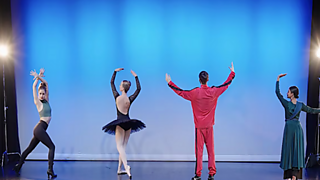- Try
- Rate
- Share
How did you rate this?

The Inside Story
We asked David Evans, a Project Technologist for Βι¶ΉΤΌΕΔ Research & Development, about how to get the stream working and what to do if there are any issues.
What will I need to listen to the stream?
Your computer needs a modern web browser which supports multi-channel audio and the most recent web standard HTML5, specifically the Media Source Extensions.
We have tested the latest versions of Chrome and Opera (Windows and OSX), IE11 and Edge (Windows 8.1 or 10 only) and Safari on OSX. Sadly, Firefox does not currently support multi-channel audio. The web browser does all the audio decoding, so you don’t need any other software. Unfortunately the experiment does not currently work on smartphones or tablets.
You will need an internet connection capable of playing a stream at 320kb/s without dropping data. A good 2Mb/s connection is the minimum that’s likely to work reliably.
What is needed for the best audio experience?
Our experiment decodes the audio in the browser so you need to get four separate channels of audio from the computer to the amplifier. You can use a “surround sound” sound card with at least four outputs or if your surround sound amplifier and computer both have HDMI that should work too. You may have success using other ways to get the sound from your computer into your audio system, for example Google Chromecast may work for you if it is plugged into a surround sound amplifier. The optical output from some computers (TOSLink) will not work because it only supports a very limited number of encoded surround sound formats, not the four separate audio channels which we need.
You also need a means to replay audio over four speakers. You can use the “corner” speakers of a traditional 5.1 setup such as a home cinema, or if your computer sound card can output four analogue audio signals you could use two stereo amplifiers and two pairs of speakers. You should arrange the speakers in an approximate square and sit somewhere near the middle – but feel free to try moving them around, it’s an experiment!
How will I know if it is working?
There’s a test available . This will allow you to test your setup before the concerts start. I’m afraid we can’t offer advice to get any particular combination of equipment working as there are so many different combinations of computer, browser, sound card and audio system available. There is information available to help you enable multi-channel audio for Windows and for Apple .
What will I hear?
You will only hear audio when there is a Βι¶ΉΤΌΕΔ Proms concert from the Royal Albert Hall being streamed on the experiment. You will not hear “normal” Βι¶ΉΤΌΕΔ Radio 3; this experiment tries to recreate the experience of being at the concert hall so you won’t get the announcements before or after the programme or the interval talk.
If you are listening on a computer surround sound system you are probably nearer the front speakers than the rear ones; in a home cinema you are probably nearer the rear speakers than the front ones, so you may need to adjust the front to back balance to get a good sound. The rear speakers will carry reverberation during the performance, which should give you a more realistic sense of location within the venue than you get with stereo. You should find applause comes from all around you, helping you feel part of the audience. Some listeners use the applause to set the front / rear balance so they are “in the middle of the audience”.
What should I do if I don’t hear any sound?
If you are connecting to a home cinema system then disconnecting and reconnecting the HDMI connection may cause the surround capabilities to be discovered. Also check that the correct input is selected. Check that the surround output is enabled, and that it is not muted, either on the computer, home cinema system or the speakers themselves.
What about if sound is coming from the wrong speakers?
If you are using speakers connected directly to a computer then check the options for the sound card are set up for the correct speaker configuration. Some sound cards pop up a dialogue asking which speakers have been connected when they detect them being plugged in.
If you are using a home cinema system then check the speakers are working correctly with some other source. Next find the settings for the sound card. Ensure that it is configured to use multichannel output and that the speaker locations are set correctly.
Why is the centre channel silent?
Our mix contains only four channels, as this is most suitable for carrying classical music. However we need to signal and include a centre channel to enable us to make use of the standard channel configurations which can be signalled in the stream.
Can I use a stereo set up?
You can, but we don't recommend it. This mix has been created specifically for multichannel, and doesn't contain any downmixing information. As a result you may hear either a best effort downmix by your computer or just the front channels. Instead you may prefer to listen to using our normal stereo streams on the Radio 3 Player or using a radio.
How are you able to send surround radio to my browser?
We're using new standards for delivery of media on the internet known as HTML5, MPEG-DASH and Media Source Extensions. You can read about the technical details in a from a previous trial.



